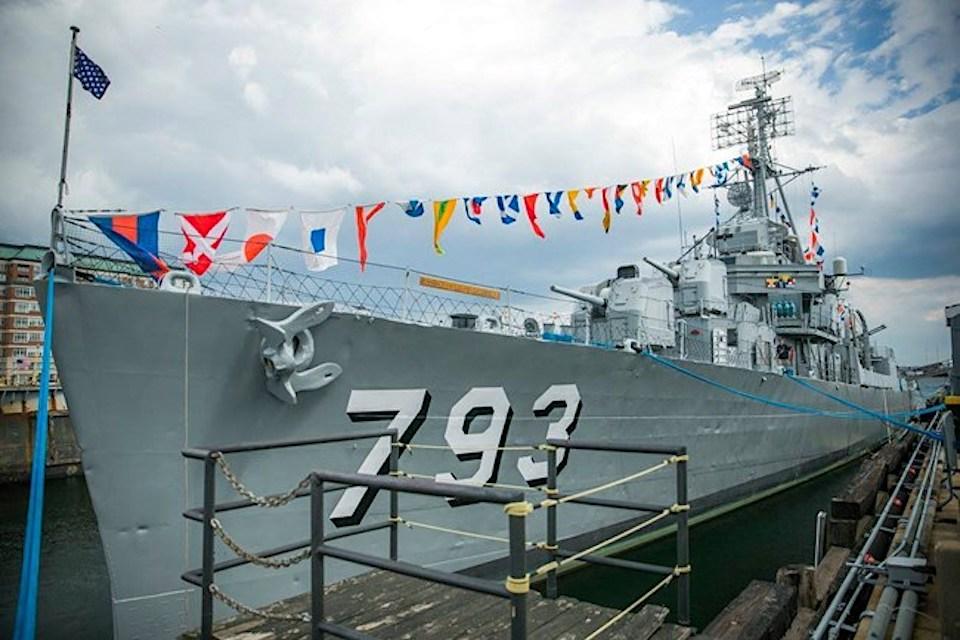
The USS Cassin Young/NPS
National Parks of Boston on Saturday will host a commemorative service and a wreath laying ceremony on the World War II-era destroyer USS Cassin Young from10:30 a.m. to 12:30 p.m. to remember and honor those who perished in the Japanese attack on the U.S. naval base at Pearl Harbor, Hawaii.
The commemoration will be held in Charlestown Navy Yard. There are three parts to the program, all located at the Charlestown Navy Yard. A morning breakfast at the USS Constitution Museum, including award-winning New York Times bestselling author William Martin; a wreath laying ceremony at the USS Cassin Young, Pier 1; and viewing of oral history interviews of survivors of the attack, in the park visitor center, which will run throughout the day.
Participating in the ceremony will be National Parks of Boston Superintendent Michael Creasey, USS Constitution Commander Nathaniel R. Shick, Massachusetts Department of Veterans Services Chief of Staff, Paul Moran; Cassin Young III, retired Navy pilot and grandson of Cassin Young, and other invited guests. The program will include musical selections by the Apollo Club of Boston, a rifle salute and rendition of “Taps” by Bugles Across America, and a gun salute from the USS Navy, USS Constitution.
At the conclusion of the ceremony, guests are invited to National Parks of Boston, Charlestown Navy Yard Visitor Center to take time to listen to and reflect on, the impact the events at Pearl Harbor have had on individuals, the nation, and the world. A special showing of recorded interviews and recollections of those who experienced the attack will be available in the visitor center theatre throughout the day.
USS Cassin Young was named for U.S. Navy Commander Cassin Young, who was awarded the Medal of Honor for his actions during the attack on Pearl Harbor. The citation reads:
For distinguished conduct in action, outstanding heroism and utter disregard of his own safety, above and beyond the call of duty, as commanding officer of the U.S.S. Vestal, during the attack on the Fleet in Pearl Harbor, Territory of Hawaii, by enemy Japanese forces on 7 December 1941. Comdr. Young proceeded to the bridge and later took personal command of the three-inch antiaircraft gun. When blown overboard by the blast of the forward magazine explosion of the U.S.S. Arizona, to which the U.S.S. Vestal was moored, he swam back to his ship. The entire forward part of the U.S.S. Arizona was a blazing inferno with oil afire on the water between the two ships; as a result of several bomb hits, the U.S.S. Vestal was afire in several places, was settling and taking on a list. Despite severe enemy bombing and strafing at the time and his shocking experience of having been blown overboard, Comdr. Young, with extreme coolness and calmness, moved his ship to an anchorage distant from the U.S.S. Arizona, and subsequently beached the U.S.S. Vestal upon determining that such action was required to save his ship.
The ship was built at San Pedro, California, and is typical of the many Fletcher-class destroyers constructed in the Charlestown Navy Yard during World War II. The ship was commissioned at the end of 1943 and first saw action in the Pacific Theatre in 1944. She took part in the landings in the Philippines, rescued survivors from the stricken carrier USS Princeton, screened the American force that sank four Japanese carriers in the battle of Cape Engano, and survived two separate kamikaze hits, one of which killed 21 crew members. No stranger to Charlestown, the ship was recalled to service in 1951 and underwent modernization at the shipyard on several occasions during the next decade before finally hauling down her commissioning pennant in 1960.
“Boston has a rich naval history and from its founding was recognized as an important port. One of the first of six Navy Yards in the country, for 175 years Charlestown Navy Yard played a vital role in building and maintaining the United States Navy fleet,” said Creasey. “Today, the National Park Service protects this national treasure, to remember those who served their country, honor the service men and women of the United States Navy who continue to serve, and provide current and future generations the opportunity to forge meaningful connections to an iconic cornerstone to the American story.”



Add comment